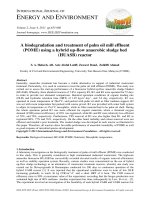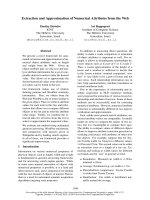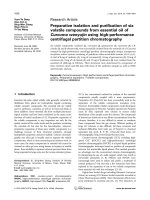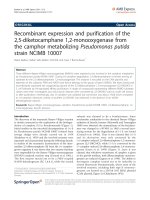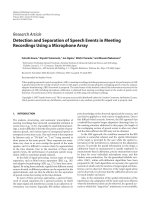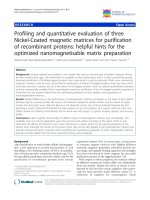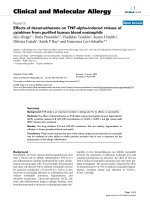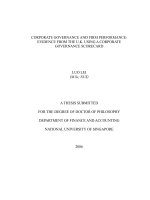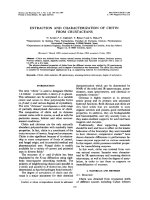Magnetic extraction and purification of DNA from whole human blood using a γ-Fe2O3@Chitosan@Polyaniline hybrid nanocomposite
Bạn đang xem bản rút gọn của tài liệu. Xem và tải ngay bản đầy đủ của tài liệu tại đây (2.02 MB, 9 trang )
Carbohydrate Polymers 197 (2018) 100–108
Contents lists available at ScienceDirect
Carbohydrate Polymers
journal homepage: www.elsevier.com/locate/carbpol
Magnetic extraction and purification of DNA from whole human blood using
a γ-Fe2O3@Chitosan@Polyaniline hybrid nanocomposite
T
Bruna Gomes Maciela, Romário Justino da Silvaa, Alicia Elizabeth Chávez-Guajardob,
⁎
Juan Carlos Medina-Llamasc, José Jarib Alcaraz-Espinozad, Celso Pinto de Meloa,d,
a
Pús-Graduaỗóo em Ciờncia de Materiais, Universidade Federal de Pernambuco, 50670-901 Recife, PE, Brazil
Unidad Académica de Ciencias de la Tierra, Universidad Autónoma de Zacatecas, 98058 Zacatecas, Zac, Mexico
c
Centro de Estudios Científicos y Tecnológicos No. 18, Instituto Politécnico Nacional, 98160 Zacatecas, Zac, Mexico
d
Departamento de Física, Universidade Federal de Pernambuco, 50670-901 Recife, PE, Brazil
b
A R T I C LE I N FO
A B S T R A C T
Keywords:
Maghemite
Chitosan
Polyaniline
Magnetic hybrid nanocomposite
DNA extraction
Human blood
We examined the properties of the nanocomposite γ-Fe2O3@Chi@Pani as an adsorbent of deoxyribonucleic acid
(DNA). As a model system, we used an aqueous solution of salmon sperm DNA, whose decreasing concentration
was followed by monitoring the 260 nm UV–vis absorption. After adjusting the data collected to a Langmuir
isotherm curve, we estimated the adsorption capacity (qe) of the nanocomposite as 49.5 mg/g. We also observed
that the kinetic model of the DNA capture presents a mixed character, with both chemical mechanisms and
intraparticle diffusion processes involved. When the MNC was used to extract the DNA from complex samples
(human blood), a capture rate of 80 ng/μL was achieved, with the collected fraction exhibiting good quality, as
evaluated by PCR analysis and electrophoresis assays. These results suggest that the γ-Fe2O3@Chi@Pani nanocomposite is a promising adsorbent for use in protocols for purification of DNA from complex samples.
1. Introduction
The elucidation of DNA function in organisms represented an unprecedent revolution in science, with special impact on the methods
used for studying living beings. Nowadays, isolating, analyzing, and
manipulating the DNA are essential steps in different areas of knowledge, such as i) the development of new biotechnological processes
(Baeshen et al., 2014; Demain & Adrio, 2007) and new drugs (Debouck
& Goodfellow, 1999), ii) finding the origin of diseases (Kruglyak,
1999), iii) making diagnostics (Drmanac et al., 1998), iv) broadening
the scope of anthropological studies (Fernández et al., 2014), and v)
solving legal issues with the help of DNA forensic research (Gill,
Jeffreys, & Werrett, 1985). Nonetheless, to achieve success in those
endeavors one needs first to extract and purify the DNA of interest, a
challenging step that continues to be laborious and time-consuming
(Tan & Yiap, 2009). In spite of the vast amount of procedures already
available for DNA purification, as a general rule the current liquid–liquid and solid phase extraction methods protocols still face important
drawbacks to be overcome. In pursuing a more efficient extraction of
DNA, several alternatives based on novel solid extraction matrices have
been developed in the last decades. Among these methods, those that
employ nanoparticles (NPs) to adsorb the nucleic acid molecules
⁎
deserve special mention, since the characteristic high surface to volume
ratio of the NPs favors the achievement of high yields in the capture of
the targeted molecules (Martin & Mitchell, 1998; Yeung & Hsing,
2006).
Extraction methods based on the use of magnetic nanoparticles
(MNPs) appear as specially convenient for their simplicity, since in this
case the fraction of interest can be easily separated from the reaction
medium by use of a small magnet, thus avoiding the necessity of further
laborious separation procedures (Lu, Salabas, & Schüth, 2007; MedinaLlamas, Chávez-Guajardo, Andrade, Alves, & de Melo, 2014). These
MNPs typically consist of a superparamagnetic nucleus (usually Fe3O4
or γ-Fe2O3) enveloped by a corona of a DNA affinity ligand (Wierucka &
Biziuk, 2014).
Examining the recent literature, it is possible to identify two main
alternative methods for coating the MNPs, either by enveloping the
magnetic core using silica (Li, Zhang, & Gu, 2012; Sheng et al., 2016;
Torney, Trewyn, Lin, & Wang, 2007) or by employing polymeric materials for this (Kievit et al., 2009; Medina-Llamas et al., 2014; Samal
et al., 2012). Silica MNPs possess the advantage of exhibiting high
porosity, and the charge distribution over their enormous superficial
area can be adjusted to better capture DNA by changes of pH or by the
controlled presence of chaotrophic agents (Li et al., 2012). In spite of
Corresponding author at: Departamento de Física, Universidade Federal de Pernambuco, 50670-901 Recife, PE, Brazil.
E-mail address: (C.P. de Melo).
/>Received 21 December 2017; Received in revised form 9 May 2018; Accepted 11 May 2018
Available online 22 May 2018
0144-8617/ © 2018 Elsevier Ltd. All rights reserved.
Carbohydrate Polymers 197 (2018) 100–108
B.G. Maciel et al.
Llamas, Andrade, & de Melo, 2015). We have exploited this latter mechanism in a previous work, to create two solid phase adsorption materials for the retrieval of nucleic acids (Medina-Llamas et al., 2014). In
the present investigation, we aim to engineer a MNP of Chi grafted with
Pani (γ-Fe2O3@Chi@Pani) for the retrieval of DNA from blood samples
with a purity degree high enough that it could be amplified by PCR. We
characterized the resulting γ-Fe2O3@Chi@Pani composite by Fourier
transform infrared spectroscopy (FT-IR), scanning electron microscopy
(SEM) and by measurements of their magnetic response.
this, use of silica-based MNPs raises some concerns not only with regard
to the total time required for the complete retrieval of the targeted
molecules, but also with respect to the quality of the purified DNA,
since denaturing DNA agents, such as guanidine hydrochloride, need to
be used in the process. Therefore, more recent efforts have been focused
in facilitating the adsorption-desorption processes by modifying the
surface chemistry of the silica MNPs, usually by the addition of silanol
moieties containing functional (such as amino) groups or polymers that
would directly respond to simple changes in the pH of the medium
(Pandit, Nanayakkara, Cao, Raghavan, & White, 2015; Sheng et al.,
2016).
Use of natural or synthetic cationic polymers appears as an alternative method of coating the MNPs, in such a manner that the resulting
polymer MNPs (P-MNPs) structure consists of an isolated particle or a
cluster of superparamagnetic nanoparticles covered by a functional
cationic polymer (Chen et al., 2013; Kievit et al., 2009; Medina-Llamas
et al., 2014). Although this methodology has not been widely explored
for the purpose of retrieving and purifying DNA molecules, some relevant examples of exploiting electrostatic complexes between cationic
polymer NPs and DNA can be found not only in the field of gene delivery, but also in the area of sensor development (Cheong et al., 2009;
Dias, Hussain, Marcos, & Roque, 2011; Kaushik, Solanki, Ansari,
Malhotra, & Ahmad, 2009; Kaushik, Solanki, Ansari, Sumana et al.,
2009). One aim in designing new NP-MNPs for DNA retrieval is to
produce biocompatible functional systems that would allow the adsorption of a large amount of the target molecules (Nishiyama &
Kataoka, 2006; Samal et al., 2012).
At the same time, it is desirable to select cost-effective procedures
based on sustainable and ecofriendly materials. On that regard,
Chitosan (Chi) appears as a very promising coating material. This
polymer, which is the second most abundant polysaccharide after cellulose, is composed of randomly distributed N-acetyl glucosamine and
D-glucosamine and can be obtained from the deacetylation of chitin
(Foster, Ho, Hook, Basuki, & Marỗal, 2015). In its structure, Chi presents three potential reactive sites (two hydroxyl groups per glycosidic
unit and a primary amine) that are susceptible to a subsequent modification and capable of interacting with negatively charged species
(Samal et al., 2012). Quaternization and grafting have been examined
as manners of functionalizing the Chi structure so as to surpass limitations such as pH sensitivity and low porosity, normally associated to
the natural form of this polysaccharide (Belalia, Grelier, Benaissa, &
Coma, 2008; Jayakumar, Prabaharan, Reis, & Mano, 2005; Marcasuzaa,
Reynaud, Ehrenfeld, Khoukh, & Desbrieres, 2010). The latter has been
successfully implemented by use of cationic polymers as poly(lysine)
(Ply) (Yu et al., 2007) or polyethylene imine (Wong et al., 2006), resulting in a material that preserves the intrinsic properties of Chi while
presenting an enhanced functionality for DNA adsorption and transfection.
In recent times, use of intrinsically conducting polymers (CPs) in
biomedical applications have attracted larger attention. Besides their
good stability, relatively simple chemical composition, and peculiar
electrical characteristics, CPs offer the possibility of entrapping biomolecules, a singular feature that has made possible to use them for the
tailoring of a new class of smart materials for a variety of applications,
such as drug delivery, the development of biosensors and the design of
scaffolds for tissue engineering, among others (Guimard, Gomez, &
Schmidt, 2007). However, the lack of solubility and the usual brittle
nature of pristine CPs limit the range of their possible applications, and
a potential manner to overcome such disadvantages is to use CPs as a
component in composite materials. Amongst the CPs, polyaniline (Pani)
stands out due to its high conductivity, rich redox properties, and the
existence of a second doping mechanism corresponding to the protonation from base emeraldine to salt emeraldine; in this process, half of
the nitrogen atoms in the polymer chain acquire a positive charge that
will be neutralized by the interaction with the anion resulting from the
dissociation of the acid (Alcaraz-Espinoza, Chávez-Guajardo, Medina-
2. Materials and methods
2.1. Materials
The reagents iron chloride II tetrahydrate (FeCl2·4H2O), salmon
sperm DNA, sodium dodecyl sulfate (SDS), ammonium persulfate (APS)
and chitosan (molecular weight 50,000–190,000 Da and deacetylation
degree 75–85%) were purchased from Sigma-Aldrich. Acetic acid
(CH3COOH), hydrochloric acid (HCl), ethylenediamine tetraacetic acid
(EDTA), sodium chloride (NaCl), ammonium hydroxide (NH4OH), sodium hydroxide (NaOH) and methanol (CH3OH) were obtained from
Química Moderna (Brazil), while aniline (C6H5NH2), sodium phosphate
monobasic (NaH2PO4), bibasic sodium phosphate (Na2HPO4) were acquired from Nuclear (Brazil). Agarose, blue/orange loading dye 6X,
diamond nucleic acid dye, glycine, proteinase K, Tris-Acetate-EDTA
40X and tris (hydroxymethyl) aminomethane (Tris) were purchased
from Promega. Iron (III) chloride hexahydrate (FeCl3·6H2O), Triton X100 and potassium acetate (CH3COOK) were obtained from Dinâmica
(Brazil), Vetec (Brazil) and Applichem (Germany), respectively. All
reagents were of analytical grade and used as received, except for
aniline that was vacuum distilled before use. In all experiments, we
used deionized water obtained from a Synergy system (Millipore, USA).
2.2. Methods
2.2.1. Synthesis of Fe3O4@Chi nanoparticles
The Fe3O4@Chi MNPs were obtained by the chemical co-precipitation method described before (Alibeigi & Vaezi, 2008; Jiang et al.,
2015). The process can be detailed as follows: a 100 mL round-bottom
flask, where we added 20.0 mL of deionized water, 2.08 g of FeCl3·6H2O
and 0.800 g of FeCl2·4H2O, was vigorously stirred for 10 min. The resulting solution was dripped into a 250 mL round-bottom flask containing 0.25 g of chitosan dissolved in 100 mL of an aqueous solution of
acetic acid 1% (v/v). The solution was stirred and heated at 1000 rpm
and 40 °C for 1 h. Afterwards, we slowly added 15 mL of an aqueous
solution of NH4OH 28% (v/v) to the flask, and stirred for 30 min. Finally, the product obtained was washed three times with a solution of
NaOH (0.03 M) and then once with deionized water. The resulting
material was then dried in a vacuum oven (40 °C) for 36 h, when a final
brown powder was obtained.
2.2.2. Synthesis of the γ-Fe2O3@Chi@Pani magnetic nanocomposite
The polymerization of aniline on the surface of the Fe3O4@Chi
MNPs was performed according to the established procedure (MedinaLlamas et al., 2014). Initially, we added 100 mL of HCl 0.1 M, 7.3 mmol
of SDS, 60 mg of MNPs and 1.5 mM of aniline in a round-bottom flask,
which was stirred for 15 min. Subsequently, 20 mL of an aqueous solution of HCl (0.1 M) containing 18 mmol of APS was added. The
polymerization reaction was allowed to proceed for 24 h at 5 °C, under
constant stirring. The resulting product was then subjected to several
successive washings with methanol (CH3OH) and deionized water, and
finally dried at 40 °C for 24 h.
2.2.3. Characterization
The Fe3O4@Chi MNPs and γ-Fe2O3@Chi@Pani MNCs were characterized by Fourier Transform Infrared Spectroscopy (FTIR), Scanning
101
Carbohydrate Polymers 197 (2018) 100–108
B.G. Maciel et al.
and mixed the contents using in a vortex for 30 s. Then, we magnetically confined the MNC and removed the supernatant. Subsequently,
we added 5 mL of a buffer solution at pH 8.0 (Tris/HCl) to the glass vial,
which was then stirred for 10 min in an orbital shaker at 230 rpm.
Finally, the MNC was once more magnetically confined, and the supernatant collected and analyzed by UV–vis.
Electron Microscopy (SEM) and magnetic measurements. FTIR spectra
of the samples of interest were obtained in the 4000–400 cm−1 range
by using pressed KBr pellets in an IRTracer-100 spectrophotometer
(Shimadzu, Japan). SEM micrographs were obtained using a FEG-SEM
MIRA 3 LM (TESCAN, Czech Republic). Magnetization curves were
acquired by the use of a EV7 vibrating sample magnetometer
(MicroSense, USA).
In the experiments of DNA retrieval from both aqueous solutions
and whole human blood samples, the DNA concentration was determined by use of a Nanodrop 2000C spectrophotometer (Thermo
Scientific, USA). The integrity and quality of extracted DNA was verified through agarose gel electrophorese and conventional PCR, using a
K33-15H (Kasvi, Brazil) horizontal electrophoresis sub-cell system, a
MB-16 (Maestrogen, USA) UV (302 nm) transilluminator and a
StepOnePlus thermocycler (Applied Biosystems, EUA), respectively.
2.2.6. Extraction of DNA from whole human blood samples
For the DNA extraction, we followed the procedure: in a 2 mL microtube, we added 5 μL of proteinase K, 100 μL of whole human blood
and 500 μL of a lysis solution (water/triton X-100 at 1%, pH 6.0). This
microtube was incubated at 56 °C for 20 min, being placed in the vortex
for 30 s at every 5 min during this period of time. After this, we added
1.2 mL of glycine/HCl/NaCl buffer solution (pH 3.3) and 4 mg of MNC
to the microtube, and allowed the DNA-MNC interaction to occur
during 10 min. Then, the MNC was magnetically confined and the supernatant discarded, and we then added 900 μL of a solution prepared
using 1.7 mL of ethanol for each 1 mL of a potassium acetate-Tris/HClEDTA solution. Afterwards, the microtube was stirred for 30 s in the
vortex, and the MNC was once again magnetically confined and the
supernatant discarded, with this process being repeated twice. After
this washing procedure, the microtube was left open for 5 min for allowing the ethanol evaporation, and we added 30 μL of an elution solution (Na2HPO4/NaH2PO4, pH 7.6). The microtube now containing the
elution solution and the MNC was then shaken for 15 s, and the system
was left in incubation for a period of 10 min, with care being taken to
ensure a good contact between the MNC and the elution solution
(Fig. 2). Finally, the MNC was magnetically confined, when the supernatant was collected and analyzed by UV–vis.
To establish whether or not the DNA extracted from blood samples
by use of the MNC was in fact of adequate quality for molecular biology
protocols, the collected material was subjected to a PCR procedure for
checking the amplification of a specific DNA sequence determined by
the primer used.
To accomplish this, we implemented a master mix, using 2.5 μL of
dNTPs 10X (0.2 mM); 2.5 μL of PCR 10 X-MgCl2 (200 mM Tris-HCl, pH
8.4 and 500 mM de KCl); 0.75 μL of MgCl2 (1.5 mM); 0.2 μL of Taq;
15.6 μL of free water, 1.0 μL of each primer (10 pmol) − forward CAT
GTA CGT TGC TAT CCA GGC and reverse CTC CTT AAT GTC ACG CAC
GAT (Mera, Heimfeld, & Faustman, 2014). Finally, we added 1.5 μL of
the extracted DNA, totaling 25 μL for each well, except for the negative
control, where 1.5 μL of nuclease free water was added. The reagents
used in this procedure were purchased from Invitrogen Life Technologies.
The amplifications were performed in a StepOnePlus thermocycler.
Initially, the sample was subjected to a temperature of 50 °C for 2 min,
and afterwards the temperature was raised to 95 °C for 3 min to allow
2.2.4. DNA adsorption experiments in a model system
The DNA adsorption experiments were performed as follows. First,
we placed 4 mg of γ-Fe2O3@Chi@Pani MNC and 2.5 mL of a glycine/
HCl pH 3.6 buffer solution in a 5 mL glass vial, and mixed them with aid
of a vortex for 5 s. Subsequently, we added 2.5 mL of sperm salmon
DNA solution into the vial that was kept under stirring for 10 min by
use of a SHKE 2000 E-CLASS orbital shaker (Barnstead Lab-Line, USA),
operating at 230 rpm. After that, the MNC was magnetically confined
and the supernatant stored in a clean flask. A 2 μL aliquot was used for
the absorbance measurements in the Nanodrop. For the quantification
of the remaining DNA concentration in solution along the adsorption
process, we determined the intensity of the characteristic 260 nm absorption peak of DNA (Fig. 1).
In these studies, we exposed different amounts of the γFe2O3@Chi@Pani MNC (2, 3, 4 and 5 mg) during distinct interaction
times (5, 10, 15, 25, 35, 45, 65, 85, 105, 125 and 145 min) with the
DNA samples. We also evaluated the adsorption capacity of the MNC as
a function of the DNA concentration (4.5; 8.5; 17.0; 33.5; 55; 118; and
173 ng/μL) in the solution.
The relationship
C0 − Cf ⎞
Adsorption% = ⎛
x100
⎝ C0 ⎠
⎜
⎟
(1)
where C0 is the initial concentration and Cf the final concentration (i.e.,
after the interaction with the MNC) of DNA in solution (both in ng/μL),
was used to determine the percentage of adsorbed DNA.
2.2.5. DNA desorption experiments in model system
After performing the adsorption experiments, we tested the DNA
desorption capacity of the MNC. For this, we placed 500 μL of a glycine/
HCl buffer solution (pH 3.6) in the glass vial that contained the MNC
Fig. 1. Scheme of the experiment used to estimate the capacity of DNA adsorption by MNC.
102
Carbohydrate Polymers 197 (2018) 100–108
B.G. Maciel et al.
Fig. 2. Procedure for extracting DNA from human blood samples.
(Fig. 3(I)). In the iron oxide/chitosan/polyaniline spectrum (curve a),
one can observe peaks at 636 cm−1 and 577 cm−1 that are due to Fe-O
vibrations of the maghemite (γ-Fe2O3) iron oxide phase (MedinaLlamas et al., 2014). In the iron oxide/chitosan spectrum (curve b),
only one peak in 621 cm−1 was found, which we associated to the Fe-O
vibrations of the magnetite (Fe3O4), in an indication of the Fe3O4 to γFe2O3 transformation that occurs after the Pani chains polymerize on
the surface of the magnetic nanoparticles (Alibeigi & Vaezi, 2008). In
curve (a), the characteristic peaks of the Pani and chitosan are present.
In the case of Pani, there are peaks at 2920 cm−1 and 2850 cm−1 that
may be attributed to the symmetric and asymmetric stretching of the
eCH2e groups, respectively. The peaks at 1564 cm−1 and 1482 cm−1
are due to the C]C stretching of the quinoid and benzenoid rings, respectively, while the peak at 796 cm−1 is attributed to CeH out of the
plane deformation in the benzenoid ring. The peaks at 1294 cm−1 and
1236 cm−1 can be assigned to the C−N stretching vibration of the
benzenoid ring, whereas the peak at 1107 cm−1 can be assigned to the
aromatic CeH in plane bending. The characteristic peaks for the chitosan (curve c) appeared at 3370 cm−1 (OeH and NeH stretching vibrations), 2873 cm−1 (also due CeH stretching vibrations), 1643 cm−1
denaturation of the double strand DNA. This step of denaturation at
95 °C, which was maintained for 30 s, was followed by the annealing of
the oligonucleotides at 50 °C for 45 s. This process was terminated with
the extension step at 72 °C for 30 s, and the final extension at 4 °C for
infinite time, a step necessary to prevent undesired amplicon reactions
that may occur before the removal of the sample from the equipment.
The denaturation, annealing and extension procedures were repeated
for 34 additional cycles.
For the purification of the amplicons, we used the QIAquick purification kit from Qiagen (Germany). After purification, the quality of
the obtained amplifications was examined by performing an agarose gel
electrophoresis, with use of a diamond dye (Promega, USA).
3. Results and discussion
3.1. Characterization of the Fe3O4@Chi MNPs and the γ-Fe2O3@Chi@
Pani MNCs
We performed FTIR analysis to examine the composition of the iron
oxide/chitosan MNPs and iron oxide/chitosan/polyaniline MNCs
Fig. 3. (I) IR spectra of γ-Fe2O3@Chi@Pani MNC (a), Fe3O4@Chi MNP (b) and Chitosan (c) and (II) Magnetization curves of Fe3O4@Chi MNPs (a) and for the γFe2O3@Chi@Pani MNC (b).
103
Carbohydrate Polymers 197 (2018) 100–108
B.G. Maciel et al.
Fig. 4. SEM image of Fe3O4@Chi (a) and γ-Fe2O3@Chi@Pani (b) samples. (Histograms of the particle size distribution in inset).
(NeH bending vibrations) and 1070 cm−1 (CeOeC stretching vibrations) (Gregorio-Jauregui et al., 2012).
By analyzing the magnetization curves of the samples (Fig. 3(II)),
we observed that at room temperature both the Fe3O4@Chi MNPs and
the γ-Fe2O3@Chi@Pani MNC exhibit a superparamagnetic behavior
with a saturation magnetization (Ms) of 42 emu/g and 22 emu/g, respectively. We attribute this decrease in the Ms of the MNC to the
presence of incorporated Pani, since the magnetization measurements
take into account the total mass of the sample and the polymer chains
do not contribute to the magnetic response (Medina-Llamas et al.,
2014). This is an additional result in agreement with the hypothesis
that Pani is incorporated in the hybrid Fe3O4@Chi MNPs structure.
We used SEM to investigate the morphology and size distribution of
the MNP and MNC. In Fig. 4, one can observe that both the Fe3O4@Chi
MNPs (Fig. 4a) and the γ-Fe2O3@Chi@Pani MNC (Fig. 4b) exhibit a
nearly spherical shape with a size distribution in the nanoscale range.
To estimate the particle size of the synthesized materials, we used the
ImageJ software to measure the diameter of 100 particles in several
SEM micrographs. After plotting the particle diameters as histograms
(see inset of Fig. 4a and b), we found that the Fe3O4@Chi MNPs have a
size distribution in the 17–31 nm range, with an average diameter of
(23 ± 6) nm, while for the γ-Fe2O3@Chi@Pani MNC the size distribution was from 23 nm to 31 nm, with an average diameter of
(27 ± 4) nm.
An important question to be addressed is whether the use of either
the MNP or the MNC would cause any level of degradation of the
captured DNA. To examine this, we repeated the adsorption experiment
but this time using as target a standard commercial kit with fragments
of known size (DNA Ladder of 1 kb, Promega, USA) (PROMEGA, 2017).
In Fig. 5, we show the results of the agarose gel electrophoresis experiment, where one can see the standard DNA diluted in nuclease-free
H2O before (lane (a)) and after interaction with the Fe3O4@Chi MNPs
(lane (b)), whose bands present a lower intensity, and with the γFe2O3@Chi@Pani MNC lane (c), whose bands are more intense. These
results confirm that the material collected by use of either the MNPs or
the MNCs is of good quality with no perceptible evidence of DNA degradation.
As expected, use of the γ-Fe2O3@Chi@Pani MNC resulted in a larger
degree of adsorption than when the Fe3O4@Chi MNP was adopted as
adsorbent. Therefore, in the subsequent adsorption experiments only
3.2. DNA adsorption experiments
To assess the DNA adsorption capacity of the γ-Fe2O3@Chi@Pani
MNC, we first investigated a model system, which was prepared by
dissolving strands of salmon sperm DNA in an aqueous solution at an
approximate concentration of 60 ng/μL. For comparison purposes, we
also tested the adsorption capacity of the Fe3O4@Chi MNPs for identical samples. In these initial experiments, we observed that after
10 min of interaction the average adsorption of the γ-Fe2O3@Chi@Pani
MNC was of the order of 61%, which corresponds to a capture of DNA
of approximately 36.2 ng/μL. On the other hand, when using the MNPs
in a similar procedure the relative amount of captured material was
smaller (16.8 ng/μL), corresponding to an average adsorption of only
29% (see Fig. S1 in the Supplementary Material).
Fig. 5. Agarose gel electrophoresis for: standard DNA diluted in nuclease-free
H2O (a), after interaction with Fe3O4@Chi MNPs (b) and γ-Fe2O3@Chi@Pani
MNC (c).
104
Carbohydrate Polymers 197 (2018) 100–108
B.G. Maciel et al.
Fig. 7. Percentage of adsorption and adsorption capacity at equilibrium as a
function of initial DNA concentration.
Fig. 6. DNA adsorption as a function of the interaction time for an amount of
2 mg (a), 3 mg (b), 4 mg (c) and 5 mg (d) of γ-Fe2O3@Chi@Pani MNC. In each
case, 2.5 mL of a 100 ng/μL DNA solution was used.
function of the equilibrium concentration Ce, in the form
qe =
the MNC was used.
(C0 − Ce )
V
m
(2)
where m is the mass of the adsorbent (in g) and V is the volume (L) of
the solution, at a given temperature.
The adsorption isotherms can provide relevant information about
the distribution of the molecules between the solution (liquid phase)
and the adsorbent (solid phase), once one adjusts the experimental data
to either the Langmuir or the Freundlich models (Javadian et al., 2014).
An isotherm obeys the Langmuir model when the adsorption occurs
with the formation of a monolayer of the adsorbed material on a
homogeneous surface, according to the relation (Faust & Aly, 2013)
3.2.1. Interaction time and optimal MNC amount
Different amounts (2–5 mg) of the γ-Fe2O3@Chi@Pani MNC were
allowed to interact with a DNA solution of concentration equal to
100 ng/μL, during different time intervals (0 a 145 min). In Fig. 6, one
can observe that the adsorption capacity increases when either the interaction time or the amount of MNC used is increased. When only 2 mg
of MNC was used, a saturation of the adsorption was observed within
the allotted time, with a low amount of captured material (curve a). Use
of higher amounts of MNC (3, 4 and 5 mg) would lead to a progressive
increase in the amount of retrieved DNA (20%, 40% and 70%, respectively − curves b, c and d) within the 145 min of interaction, but
with no indication that the saturation regime was already attained. We
have then decided to adopt a fixed amount of 2 mg of the γFe2O3@Chi@Pani MNC in the subsequent analyzes to ensure that the
equilibrium concentration was reached in each case.
Ce
1
C
=
+ e
qe
bqm
qm
(3)
where b is the Langmuir constant and qm is the maximum amount of
adsorbed molecules (mg/g). The values of b and qm can be determined
by plotting the data as a Ce/qe vs. Ce graph. On the other hand, the
Freundlich model, which is more suitable for the description of an
adsorption process that occurs with the formation of multilayers on a
heterogeneous surface, obeys the relation (Ho, Porter, & McKay, 2002)
3.2.2. Effect of initial DNA concentration
After assessing both the appropriate amount of the γ-Fe2O3@Chi@
Pani MNC to be used and the most adequate interaction time for a good
adsorption rate of the dissolved DNA, we investigated the effect of the
initial DNA concentration upon the adsorption process. For this, a fixed
amount of 2 mg of the MNC placed to interact with 5 mL from solutions
of different initial concentrations of DNA (4.5; 8.5; 17.0; 33.5; 55; 118;
and 173 ng/μL), with the mixtures being stirred during 60 min in an
orbital shaker.
In Fig. 7, one can observe that at low concentrations (4.5; 8.5;
17.0 ng/μL) the amount of MNC used was able to completely adsorb the
dissolved DNA. One can also notice that, as the DNA concentration
increases, the percentage of adsorbed material decreases and the adsorption capacity increases. For instance, for the concentrations of
33.5 ng/μL and 118 ng/μL the corresponding adsorption percentage
was of the order of 54% and 17%, while the adsorption capacity was
45 mg and 49.5 mg DNA/g MNC, respectively. Thus, although the
percentage of adsorption is decreased, the mass adsorption capacity
increases, due to the increase in the corresponding driving force
(Wasewar, 2010).
log qe = logKf +
1
logCe
n
(4)
where qe is the adsorption capacity, and Kf and n are constants that can
be determined from a logqe vs. logKf plot. In Table 1 we present the
values of the parameters of the Langmuir and Freundlich models obtained after adjusting the data. In Fig. S2, we show the corresponding
linear fittings. One can note that, as indicated by the values of the
coefficient of determination R2, the DNA adsorption follows a Langmuir
process; in fact, the experimental value for the adsorption capacity
determined according to this model (49.5 mg/g) agrees with that calculated by use of Eq. (2).
Table 1
Isotherm parameters for the Langmuir and Freundlich models applied to the
DNA adsorption on the γ-Fe2O3@Chi@Pani MNC.
Langmuir
3.3. Adsorption isotherms
To analyze the characteristics of the adsorption process, we first
examined how the adsorption capacity at equilibrium (qe) varies as a
105
qm
(mg/g)
b (mg/L)
49.5
1.89
Freundlich
Kf(mg/g)
R2
0.99
22.39
n
R2
5.88
0.37
Carbohydrate Polymers 197 (2018) 100–108
B.G. Maciel et al.
percentage of the γ-Fe2O3@Chi@Pani MNC (as well as the time required to complete each of these steps) to those of other adsorbents
described in the literature – see Table S1.
The γ-Fe2O3@Chi@Pani MNC has an adsorption capacity of
49.5 mg/g, which is reached after 60 min of interaction. Teng et al.
(Teng, Li, Yan, Zhao, & Yang, 2009) estimated a capacity of 46 mg/g in
20 min when using 10 mg of magnetite nanoparticles coated with mesoporous silica, and to promote the DNA desorption they used a Tris/
EDTA solution at pH 8.0, which was heated at 60 °C during 20 min.
Zhang et al. (Zhang et al., 2012) used 1 mg of polystyrene-coated mesoporous silica nanoparticles, and obtained an adsorption capacity of
110.7 mg/g after 1440 min of interaction. Sun et al. (Sun et al., 2014)
reported that employing 0.5 mg of M-MSN@TEOS in 120 min adsorbed
10.6 mg/g. However, note that in the latter work guanidine thiocyanate
was used. This reagent is not only toxic, but also absorbs at wavelengths
near 260 nm; hence, additional purification steps need to be performed
to eliminate its presence from the medium. Finally, Hu and collaborators (Hu et al., 2015) have used an iron phosphate@Polyethyleneimine
MNC that showed both higher adsorption and larger desorption capacity in shorter times than the γ-Fe2O3@Chi@Pani MNC; however, in
this process it was necessary to adopt centrifugation as an additional
step.
Compared to these adsorbents, the MNC described in this work
presents the competitive advantage of demanding a simple procedure
for the magnetic separation of the captured DNA, while not requiring
the use of toxic reagents, such as guanidine thiocyanate.
3.4. Kinetics of the adsorption process
One can obtain more information on how the γ-Fe2O3@Chi@Pani
MNC interacts with the DNA strands by studying the kinetics of the
adsorption process. For this, we adjusted the experimental data to the
pseudo first order, pseudo second order and Morris-Weber kinetic
models (Haerifar & Azizian, 2013; Largergren, 1898; Plazinski &
Rudzinski, 2009).
Each one of these models can be expressed in its linearized form
according to
log (qe − qt ) = log qe −
t
qt
=
1
h
+
1
qe t ,
k1
t
2.303
(Pseudo − first order),
(5)
h = k2 qe2 (Pseudo − second order: ), or
(6)
qt = kid (t )0.5 + C (Morris − Wener),
(7)
where qe and qt are the amounts (in mg) of DNA adsorbed per mass unit
(g) of the MNC, at equilibrium and at time t, respectively, while k1
(min−1), k2 (g/mg.min) and kid(min−1) are the pseudo-first-order,
pseudo-second-order and intraparticle diffusion adsorption kinetic rate
constants, respectively, t (min) is the time and C is an intraparticle
diffusion constant. The constants of these models were calculated from
the intercept and the slope of the plots, which were constructed according to the Eqs. (5)–(7), respectively (see Table 2).
As suggested by the comparison of the corresponding coefficients
and by the fittings shown in Fig. S3, the process is best described
(R2 = 0.94) by a chemical process (i.e., the pseudo-second order
model), with a possible contribution (R2 = 0.92) of Morris-Weber intraparticle diffusion mechanisms.
We can rationalize these results if we assume that a competition
exists between these two kinetic models, and that the processes of adsorption and absorption of the DNA molecules on the MNC occur concomitantly, as schematically represented in Fig. S4. According to this
view, the DNA strands initially interact with the polyaniline chains
through the electrostatic attraction between the cationic charges of the
amino groups and the negatively charged DNA phosphate groups (Fig.
S4-1). Afterwards, the DNA migrates through the interstices of the Pani
coating, reaching the more internal chitosan sites (which also have
amine groups) (Fig. S4-2). As a result of this dual process, the γFe2O3@Chi@Pani MNC exhibits an increased capture rate of the target
molecule.
3.7. Extraction of DNA from whole human blood samples
After having established the most suitable conditions for the extraction of DNA strands dissolved in an aqueous medium, we proceed to
examine the performance of the MNC for the capture of DNA present in
human blood samples, a system of much greater complexity.
Blood is a tissue composed of plasma and serum (liquid), with solid
components consisting of red cells (erythrocytes), white blood cells
(leukocytes) and platelets (thrombocytes), whose main function is to
transport oxygen and nutrients throughout the body (Butler, 2009).
Complex samples such as blood have components called inhibitors –
such as hemoglobin, immunoglobulin G, and lactoferrin (Kermekchiev,
Kirilova, Vail, & Barnes, 2009) – that prevent the action of DNA polymerase, thus making unfeasible the direct application of whole blood in
PCR amplification procedures.
Taking this into account, we considered the blood composition in
the development of a MNC based protocol for the capture of DNA with a
satisfactory purity for molecular biology applications. As a more unstable nucleic acid, RNA chains are not well preserved due to the alkaline hydrolysis and the presence of alkali metals that favor their
degradation (Oivanen, Kuusela, & Lönnberg, 1998), and one could expect that the resulting RNA fragments should compete for adsorption on
the active sites of the MNC. However, in human blood the overall
amount of RNA is much lesser than that of DNA (Chomczynski et al.,
2016), so that at the end the extracted material will be mostly composed by DNA molecules. In fact, before establishing the best extraction
protocol to be followed, we examined how the results would be affected
when either 40 μg or 200 μg of RNase was added in the lysing step. As
the results shown in Fig. S5 reveal for both cases, no significant differences could be detected either in the UV–vis spectra of the final
3.5. DNA desorption experiments
It is known (Cao, Easley, Ferrance, & Landers, 2006; Matsumoto,
Yako, Minagawa, & Tanioka, 2007) that the adsorption of DNA strands
occurs more effectively at lower pH values, with a significant decrease
being observed at pH > 6.5. Since the latter pH range is the most suitable for an effective elution of the captured molecules, in the subsequent desorption studies for the model system we used a pH 8.0 Tris/
HCl buffer solution. Our results indicated a desorption rate of
(66.0 ± 0.97) % for the MNC.
3.6. γ-Fe2O3@Chi@Pani MNC as an adsorbent: comparison to other
materials
We compared the adsorption capacity and the desorption
Table 2
Kinetic parameters for DNA adsorption with nanocomposite γ-Fe2O3@Chi@Pani.
Pseudo first order
Pseudo second order
Morris-Weber
K1 (min−1)
qe (mg/g)
R2
K2 (g/mg.min)
qe (mg/g)
R2
Kid (min−1)
R2
2.3 × 10−3
43.65
0.88
1.5 × 10−3
20
0.94
1.31
0.92
106
Carbohydrate Polymers 197 (2018) 100–108
B.G. Maciel et al.
Fig. 8. (I) Images of agarose gel electrophoresis of the DNA extracted from human blood using Fe3O4@Chi MNPs (a) and γ-Fe2O3@Chi@Pani MNC (b) and (II)
electrophoresis experiment using reference DNA standard (a), PCR amplified DNA extracted from human blood by use of MNPs (b), negative sample (c) and PCR
amplified DNA extracted from human blood by use of MNC (d).
coated with polyaniline by means of emulsion polymerization of the
aniline monomers. During the polymerization in an aqueous medium, a
transformation of the magnetite nanoparticles to the maghemite phase
occurs, resulting in the formation of maghemite/chitosan/polyaniline
hybrid nanocomposites. We examined the properties of the nanocomposite γ-Fe2O3@Chi@Pani as an adsorbent of DNA, using a model
system consisting of an aqueous solution of salmon sperm DNA. To the
best of our knowledge, no previous report of using γ-Fe2O3@Chi@Pani
MNC for the DNA adsorption is available in the literature. We have
found that these magnetic nanocomposites exhibit an enhanced efficiency when compared to that of other adsorbents discussed in the
literature, and we present arguments suggesting that this observed
larger degree of capture is associated to a dual adsorption/diffusion
character of the interaction between the DNA and the nanoparticles.
When we applied these MNCs to extract DNA from human blood samples, the quality and purity of the collected material had the adequate
levels for use in PCR amplification experiments. We believe that these
hybrid nanocomposites represent a promising low cost and convenient
material that could be easily incorporated in purification protocols for
different applications in molecular biology and in the area of diagnostics.
extracted material or in the real-time PCR amplification curves relative
to what is obtained when no RNase was introduced in the process.
Hence, in the final protocol we first added proteinase K to the whole
blood sample to induce the proteins present to degrade, and then a lysis
solution (water-triton X-100) is used to disrupt the cellular membrane.
Then, we added a glycine/HCl/NaCl solution for promoting the interaction between the MNC and the DNA of the lysed sample. After that,
the DNA-MNC complex with could be separated with the help of a
magnet and the supernatant discarded. In a subsequent step, we removed cellular debris, and magnesium and calcium in excess by adding
Tris-HCl/EDTA and potassium acetate and ethanol. Finally, the captured DNA fraction was eluted by applying a Na2HPO4/NaH2PO4, with
the objective of deprotonating the Pani chains and so interrupting the
interaction.
By using UV–vis absorption spectroscopy to assess the amount of
DNA extracted, we determined an average DNA adsorption capacity of
(54.2 ± 0.08) ng/μL for the Fe3O4@Chi MNPs and of (80 ± 0.14) ng/
μL for the γ-Fe2O3@Chi@Pani MNC and a value for the 260/280 ratio
of 1.86 and 1.71, respectively. In all UV–vis spectra, the peak at 260 nm
(which corresponds to DNA absorption) is well-defined. Iron oxide
presents an absorption in the range from 250 to 400 nm, chitosan
around 300 nm and Pani at 323 and 636 nm. In Fig. S6, we show the
(200–800) nm spectrum of the DNA from blood sample of the MNC,
confirming the absence of spurious absorption bands.
We must stress, however, that the UV–vis absorption results can
only be taken as a convenient indicator of the quality of the sample
(OGT, 2011); hence, we carried out an agarose gel electrophoresis to
assess the integrity and purity of the DNA extracted from the blood
sample. In Fig. 8(I), it is possible to observe the presence of well-defined
bands, with no traces, confirming the purity and integrity of the purified nucleic acid fraction.
To a further confirmation of this, we submitted the extracted DNA
sample to a PCR amplification with the β-actin primers and used the
resulting material in an agarose gel electrophoresis experiment
(Fig. 8(II)), comparing the observed bands to those of a reference
standard (ID 4501885a1). The presence of a significant band associated
to fragments corresponding to 250 base pairs demonstrated that the
DNA fraction extracted by use of the γ-Fe2O3@Chi@Pani MNC has the
adequate quality use in molecular biology procedures. In fact, since no
inhibitors were present in the DNA extracted using the MNC, its amplification by PCR became possible.
Acknowledgment
This work was supported by the Brazilian agencies FACEPE, CNPq,
CAPES, Brazilian Ministry of Health. BGM, RJS and JJAE are grateful
for CAPES, CNPq and FACEPE scholarships, respectively. Juan Medina
and Alicia Chávez are grateful to the Mexican agency CONACyT. The
authors would like to thank Dr. Alexandre Ricalde Rodrigues, Dr. Valdir
Balbino, the technical staff of the Department of Fundamental
Chemistry and the of Department of Physics of the UFPE for their expertise and use of the instrumentation needed to characterize our materials.
Appendix A. Supplementary data
Supplementary data associated with this article can be found, in the
online version, at />References
Alcaraz-Espinoza, J. J., Chávez-Guajardo, A. E., Medina-Llamas, J. C., Andrade, C. A. S., &
de Melo, C. P. (2015). Hierarchical composite polyaniline–(electrospun polystyrene)
fibers applied to heavy metal remediation. ACS Applied Materials & Interfaces, 7(13),
7231–7240.
Alibeigi, S., & Vaezi, M. R. (2008). Phase transformation of iron oxide nanoparticles by
4. Conclusion
We synthesized magnetite/chitosan nanoparticles that were later
107
Carbohydrate Polymers 197 (2018) 100–108
B.G. Maciel et al.
Kruglyak, L. (1999). Prospects for whole-genome linkage disequilibrium mapping of
common disease genes. Nature Genetics, 22(2), 139–144.
Largergren, S. (1898). Zur theorie der sogenannten adsorption geloster stoffe. Kungliga
Svenska Vetenskapsakademiens. Handlingar, 24(4), 1–39.
Li, X., Zhang, J., & Gu, H. (2012). Study on the adsorption mechanism of DNA with
mesoporous silica nanoparticles in aqueous solution. Langmuir, 28(5), 2827–2834.
Lu, A.-H., Salabas, E. L., & Schüth, F. (2007). Magnetic nanoparticles: Synthesis, protection, functionalization, and application. Angewandte Chemie International Edition,
46(8), 1222–1244.
Marcasuzaa, P., Reynaud, S., Ehrenfeld, F., Khoukh, A., & Desbrieres, J. (2010). Chitosangraft-polyaniline-based hydrogels: Elaboration and properties. Biomacromolecules,
11(6), 1684–1691.
Martin, C. R., & Mitchell, D. T. (1998). Peer reviewed: Nanomaterials in analytical
chemistry. Analytical Chemistry, 70(9), 322A–327A.
Matsumoto, H., Yako, H., Minagawa, M., & Tanioka, A. (2007). Characterization of
chitosan nanofiber fabric by electrospray deposition: Electrokinetic and adsorption
behavior. Journal of Colloid and Interface Science, 310(2), 678–681.
Medina-Llamas, J. C., Chávez-Guajardo, A. E., Andrade, C. A. S., Alves, K. G. B., & de
Melo, C. P. (2014). Use of magnetic polyaniline/maghemite nanocomposite for DNA
retrieval from aqueous solutions. Journal of Colloid and Interface Science,
434(Supplement C), 167–174.
Mera, T., Heimfeld, S., & Faustman, D. (2014). The spleen contributes stem cells to
peripheral blood stem cell transplants. J Stem Cell Res Ther, 4(253), 2.
Nishiyama, N., & Kataoka, K. (2006). Current state, achievements, and future prospects of
polymeric micelles as nanocarriers for drug and gene delivery. Pharmacology &
Therapeutics, 112(3), 630–648.
OGT (2011). Understanding and measuring variations in DNA sample quality. http://www.
ogt.co.uk/resources/literature/483_understanding_and_measuring_variations_in_dna_
sample_quality. (Accessed 7 December 2016).
Oivanen, M., Kuusela, S., & Lönnberg, H. (1998). Kinetics and mechanisms for the cleavage and isomerization of the phosphodiester bonds of RNA by Brønsted acids and
bases. Chemical Reviews, 98(3), 961–990.
PROMEGA (2017). 1kb DNA ladder. />(Accessed 2017).
Pandit, K. R., Nanayakkara, I. A., Cao, W., Raghavan, S. R., & White, I. M. (2015). Capture
and direct amplification of DNA on chitosan microparticles in a single PCR-Optimal
solution. Analytical Chemistry, 87(21), 11022–11029.
Plazinski, W., & Rudzinski, W. (2009). Kinetics of adsorption at solid/solution interfaces
controlled by intraparticle diffusion: A theoretical analysis. The Journal of Physical
Chemistry C, 113(28), 12495–12501.
Samal, S. K., Dash, M., Van Vlierberghe, S., Kaplan, D. L., Chiellini, E., van Blitterswijk,
C., ... Dubruel, P. (2012). Cationic polymers and their therapeutic potential. Chemical
Society Reviews, 41(21), 7147–7194.
Sheng, W., Wei, W., Li, J., Qi, X., Zuo, G., Chen, Q., ... Dong, W. (2016). Amine-functionalized magnetic mesoporous silica nanoparticles for DNA separation. Applied
Surface Science, 387(Supplement C), 1116–1124.
Sun, N., Deng, C., Liu, Y., Zhao, X., Tang, Y., Liu, R., ... Ge, G. (2014). Optimization of
influencing factors of nucleic acid adsorption onto silica-coated magnetic particles:
Application to viral nucleic acid extraction from serum. Journal of Chromatography A,
1325, 31–39.
Tan, S. C., & Yiap, B. C. (2009). DNA, RNA, and protein extraction: The past and the
present. BioMed Research International, 2009.
Teng, Z., Li, J., Yan, F., Zhao, R., & Yang, W. (2009). Highly magnetizable superparamagnetic iron oxide nanoparticles embedded mesoporous silica spheres and their
application for efficient recovery of DNA from agarose gel. Journal of Materials
Chemistry, 19(13), 1811–1815.
Torney, F., Trewyn, B. G., Lin, V. S. Y., & Wang, K. (2007). Mesoporous silica nanoparticles deliver DNA and chemicals into plants. Nat Nano, 2(5), 295–300.
Wasewar, K. L. (2010). Adsorption of metals onto tea factory waste: A review.
International Journal of Research and Reviews in Applied Sciences, 3(3), 303–322.
Wierucka, M., & Biziuk, M. (2014). Application of magnetic nanoparticles for magnetic
solid-phase extraction in preparing biological, environmental and food samples. TrAC
Trends in Analytical Chemistry, 59(Supplement C), 50–58.
Wong, K., Sun, G., Zhang Dai, H., Liu, Y., & He Leong, K. W. (2006). PEI-g-chitosan, a
novel gene delivery system with transfection efficiency comparable to polyethylenimine in vitro and after liver administration in vivo. Bioconjugate Chemistry,
17(1), 152–158.
Yeung, S. W., & Hsing, I. M. (2006). Manipulation and extraction of genomic DNA from
cell lysate by functionalized magnetic particles for lab on a chip applications.
Biosensors and Bioelectronics, 21(7), 989–997.
Yu, H., Chen, X., Lu, T., Sun, J., Tian, H., Hu, J., ... Jing, X. (2007). Poly(l-lysine)-graftchitosan copolymers: Synthesis, characterization, and gene transfection effect.
Biomacromolecules, 8(5), 1425–1435.
Zhang, J., Sun, W., Bergman, L., Rosenholm, J. M., Lindén, M., Wu, G., ... Gu, H.-c.
(2012). Magnetic mesoporous silica nanospheres as DNA/drug carrier. Materials
Letters, 67(1), 379–382.
varying the molar ratio of Fe2+: Fe3+. Chemical Engineering & Technology, 31(11),
1591–1596.
Baeshen, N. A., Baeshen, M. N., Sheikh, A., Bora, R. S., Ahmed, M. M. M., Ramadan, H. A.,
... Redwan, E. M. (2014). Cell factories for insulin production. Microbial Cell Factories,
13(1), 141.
Belalia, R., Grelier, S., Benaissa, M., & Coma, V. (2008). New bioactive biomaterials based
on quaternized chitosan. Journal of Agricultural and Food Chemistry, 56(5),
1582–1588.
Butler, J. M. (2009). Fundamentals of forensic DNA typing. Academic Press.
Cao, W., Easley, C. J., Ferrance, J. P., & Landers, J. P. (2006). Chitosan as a polymer for
pH-induced DNA capture in a totally aqueous system. Analytical Chemistry, 78(20),
7222–7228.
Chen, C.-K., Jones, C. H., Mistriotis, P., Yu, Y., Ma, X., Ravikrishnan, A., ... Cheng, C.
(2013). Poly(ethylene glycol)-block-cationic polylactide nanocomplexes of differing
charge density for gene delivery. Biomaterials, 34(37), 9688–9699.
Cheong, S.-J., Lee, C.-M., Kim, S.-L., Jeong, H.-J., Kim, E.-M., Park, E.-H., ... Sohn, M.-H.
(2009). Superparamagnetic iron oxide nanoparticles-loaded chitosan-linoleic acid
nanoparticles as an effective hepatocyte-targeted gene delivery system. International
Journal of Pharmaceutics, 372(1), 169–176.
Chomczynski, P., Wilfinger, W. W., Eghbalnia, H. R., Kennedy, A., Rymaszewski, M., &
Mackey, K. (2016). Inter-Individual differences in RNA levels in human peripheral
blood. PUBLIC LIBRARY OF SCIENCE, 11(2), e0148260.
Debouck, C., & Goodfellow, P. N. (1999). DNA microarrays in drug discovery and development. Nature Genetics, 21, 48–50.
Demain, A. L., & Adrio, J. L. (2007). Contributions of microorganisms to industrial
biology. Molecular Biotechnology, 38(1), 41.
Dias, A. M. G. C., Hussain, A., Marcos, A. S., & Roque, A. C. A. (2011). A biotechnological
perspective on the application of iron oxide magnetic colloids modified with polysaccharides. Biotechnology Advances, 29(1), 142–155.
Drmanac, S., Kita, D., Labat, I., Hauser, B., Schmidt, C., Burczak, J. D., & Drmanac, R.
(1998). Accurate sequencing by hybridization for DNA diagnostics and individual
genomics. Nat Biotech, 16(1), 54–58.
Faust, S. D., & Aly, O. M. (2013). Adsorption processes for water treatment. Elsevier.
Fernández, E., Pérez-Pérez, A., Gamba, C., Prats, E., Cuesta, P., Anfruns, J., & Turbón, D.
(2014). Ancient DNA analysis of 8000 B.C. near eastern farmers supports an early
neolithic pioneer maritime colonization of mainland Europe through Cyprus and the
Aegean islands. PLOS Genetics, 10(6), e1004401.
Foster, L. J. R., Ho, S., Hook, J., Basuki, M., & Marỗal, H. (2015). Chitosan as a biomaterial: Inuence of degree of deacetylation on its physiochemical, material and biological properties. PUBLIC LIBRARY OF SCIENCE, 10(8), e0135153.
Gill, P., Jeffreys, A. J., & Werrett, D. J. (1985). Forensic application of DNA/‘fingerprints/
’. Nature, 318(6046), 577–579.
Gregorio-Jauregui, K. M., Pineda, M. G., Rivera-Salinas, J. E., Hurtado, G., Saade, H., &
Martinez, J. G. (2012). One-step method for preparation of magnetic nanoparticles
coated with chitosan. Journal of Nanomaterials, 2012, 8.
Guimard, N. K., Gomez, N., & Schmidt, C. E. (2007). Conducting polymers in biomedical
engineering. Progress in Polymer Science, 32(8), 876–921.
Haerifar, M., & Azizian, S. (2013). An exponential kinetic model for adsorption at solid/
solution interface. Chemical Engineering Journal, 215, 65–71.
Ho, Y., Porter, J., & McKay, G. (2002). Equilibrium isotherm studies for the sorption of
divalent metal ions onto peat: Copper, nickel and lead single component systems.
Water, Air, & Soil Pollution, 141(1), 1–33.
Hu, L.-L., Hu, B., Shen, L.-M., Zhang, D.-D., Chen, X.-W., & Wang, J.-H. (2015).
Polyethyleneimine-iron phosphate nanocomposite as a promising adsorbent for the
isolation of DNA. Talanta, 132, 857–863.
Javadian, H., Ghaemy, M., & Taghavi, M. (2014). Adsorption kinetics, isotherm, and
thermodynamics of Hg2+ to polyaniline/hexagonal mesoporous silica nanocomposite in water/wastewater. Journal of Materials Science, 49(1), 232–242.
Jayakumar, R., Prabaharan, M., Reis, R. L., & Mano, J. F. (2005). Graft copolymerized
chitosan—present status and applications. Carbohydrate Polymers, 62(2), 142–158.
Jiang, X., Cheng, J., Zhou, H., Li, F., Wu, W., & Ding, K. (2015). Polyaniline-coated
chitosan-functionalized magnetic nanoparticles: Preparation for the extraction and
analysis of endocrine-disrupting phenols in environmental water and juice samples.
Talanta, 141, 239–246.
Kaushik, A., Solanki, P. R., Ansari, A. A., Malhotra, B. D., & Ahmad, S. (2009). Iron oxidechitosan hybrid nanobiocomposite based nucleic acid sensor for pyrethroid detection.
Biochemical Engineering Journal, 46(2), 132–140.
Kaushik, A., Solanki, P. R., Ansari, A. A., Sumana, G., Ahmad, S., & Malhotra, B. D.
(2009). Iron oxide-chitosan nanobiocomposite for urea sensor. Sensors and Actuators
B: Chemical, 138(2), 572–580.
Kermekchiev, M. B., Kirilova, L. I., Vail, E. E., & Barnes, W. M. (2009). Mutants of Taq
DNA polymerase resistant to PCR inhibitors allow DNA amplification from whole
blood and crude soil samples. Nucleic Acids Research, 37(5), e40.
Kievit, F. M., Veiseh, O., Bhattarai, N., Fang, C., Gunn, J. W., Lee, D., ... Zhang, M. (2009).
PEI-PEG-chitosan-copolymer-coated iron oxide nanoparticles for safe gene delivery:
Synthesis, complexation, and transfection. Advanced Functional Materials, 19(14),
2244–2251.
108
